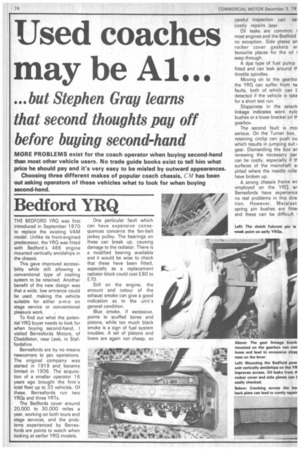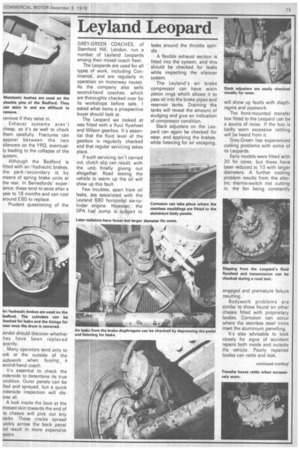Used coaches may be Al...
Page 78

Page 79

Page 80

If you've noticed an error in this article please click here to report it so we can fix it.
but Stephen Gray learns that second thoughts pay off before buying second-hand
MORE PROBLEMS exist for the coach operator when buying second-hand than most other vehicle users. No trade guide books exist to tell him what price he should pay and its very easy to be misled by outward appearances.
Choosing three different makes of popular coach chassis, CM has been out asking operators of these vehicles what to look for when buying second-hand.
Bedford YRQ
THE BEDFORD YRQ was first introduced in September 1970 to replace the existing VAM model. Unlike its front-engined predecessor, the YRQ was fitted with Bedford's 466 engine mounted vertically amidships in the chassis.
This gave improved accessibility while still allowing a conventional type of cooling system to be retained. Another benefit of the new design was that a wide, low entrance could be used, making the vehicle suitable for either o-m-o on stage service or conventional pleasure work. To find out what the potential YRQ buyer needs to look for when buying second-hand, I visited Berresfords Motors, of Cheddleton, near Leek, in Staffordshire.
Berresfords are by no means newcomers to psv operations. The original company was started in 1919 and became limited in 1936. The acquisition of a smaller operator 16 years ago brought the firm's total fleet up to 33 vehicles. Of these, Berresfords run two YRQs and three YRTs.
The Bedfords cover around 20,000 to 30,000 miles a year, working on both tours and stage services, and the problems experienced by Berresfords are points to watch when looking at earlier YRQ models One particular fault which can have expensive consequences concerns the fan-belt jockey pulley. The bearings on these can break up, causing damage to the radiator. There is a modified bearing available and it would be wise to check that these have been fitted, especially as a replacement radiator block could cost £60 to £70.
Still on the engine, the amount and colour of the exhaust smoke can give a good indication as to the unit's general condition, Blue, smoke, if excessive, points to scuffed bores and pistons, while too much black smoke is a sign of fuel system troubles. A set of pistons and liners are again not cheap, so careful inspection can sal costly repairs later.
Oil leaks are common I most engines and the Bedford no exception. Side plates an rocker cover gaskets ar favourite places for the oil 1 seep through.
A dpa type of fuel pump fitted and can leak around th throttle spindles.
Moving on to the gearbo: the YRQ can suffer from tw faults, both of which can t detected if the vehicle is take for a short test run.
Sloppiness in the select( linkage indicates worn nylo bushes or a loose bracket on fl' gearbox.
The second fault is moi serious. On the Turner box, retaining circlip can push ou which 'results in jumping out c gear. Dismantling the box an renewing the necessary par can be costly, especially if tlsurfaces of the mainshaft ai pitted where the needle rolle have broken up.
A strong chassis frame INF employed on the YRQ an Berresfords have experience no real problems in this dire tion However, Metalast spring pin bushes are fittei and these can be difficult 1
remove if they seize in.
Exhaust systems aren't cheap, so it's as well to check them carefully. Fractures can appear between the two silencers on the YRQ, eventually leading to the collapse of the system.
Although the Bedford is fitted with air/hydraulic brakes, the park/secondary is by means of spring brake units at the rear. In Berresfords' experience, these tend to seize after a year to 18 months and can cost around £80 to replace.
Prudent questioning of the fendor should discover whether hey have been replaced ecently.
Many operators tend only to Dok at the outside of the )odywork when buying_ a econd-hand coach.
It's essential to check the inderside to determine its true ondition. Outer panels can be illed and sprayed, but a quick inderside inspection will dislose all.
A look inside the boot at the tressed skin towards the end of le chassis will pick out any racks. These cracks spread uickly across the back panel nd result in more expensive apairs.
eyland Leopard
GREY-GREEN COACHES, of Stamford Hill, London, run a number of Leyland Leopards among their mixed coach fleet.
The Leopards are used for all types of work, including Continental, and are regularly in operation on motorway routes. As the company also sells second-hand coaches, which are thoroughly checked over by its workshops before sale. I asked what items a prospective buyer should look at.
The Leopard we looked at was fitted with a fluid flywheel and Wilson gearbox. It's essential that the fluid level of the gearbox is regularly checked and that regular servicing takes place.
If such servicing isn't carried out, clutch slip can result, with the unit finally giving out altogether. Road testing the vehicle to warm up the oil will show up this fault.
Few troubles, apart from oil leaks, are associated with the Leyland 680 horizontal six-cylinder engine. However, the DPA fuel pump is subject to leaks around the throttle spindle.
A flexible exhaust section is fitted into the system, and this should be checked for leaks while inspecting the silencer system.
The Leyland's air brake compressor can have worn piston rings which allows it to pass oil into the brake pipes and reservoir tanks. Draining the tanks will reveal the amount of sludging and give an indication of compressor condition.
Slack adjusters on the Leopard can again be checked for wear, and applying the brakes, while listening for air escaping, will show up faults with diaphragms and pipework.
The front-mounted transfer box fitted to the Leopard can be a source of noise. If the box is badly worn excessive rattling will be heard from it.
Grey-Green has experienced cooling problems with some of its Leopards.
Early models were fitted with 20 fin cores, but these have been reduced to 10 with larger diameters. A further cooling problem results from the elecL tric thermo-switch not cutting in, the fan being constantly engaged and premature failure resulting.
Bodywork problems are similar to those found on other chassis fitted with proprietary bodies. Corrosion can occur where the stainless steel trims meet the aluminium panelling.
It's also advisable to look closely for signs of accident repairs both inside and outside the vehicle. Poorly repaired bodies can rattle and leak
Ford R-Series•
FORD came into the coach market in 1959, with the introduction of a coach chassis based on the Thames Trader Truck. This chassis remained in production until 1968, although the designation of RSeries came in 1965 when the D-Series truck was first produced.
Similar components to those used on the 0-Series were then used for the coach, the naturally .aspirated 360 power unit eventually changing to the turbocharged engine from the truck series.
In the pay application, however, it is mounted vertically, although Tricentrol (A5) Ltd, of Dunstable, offers an inclined conversion. This conversion lowers the floor at the front of the coach, but adds substantially to the vehicle's cost.
talked to Sharon Coaches, of Addlestone, and Whites Coaches, Camberley, about their • experiences with the R-Series in an endeavour to get Some guidance when buying second-hand.
Jack Waters, of Sharon Coaches, runs seven Fords, two of which are new and fitted with Mosley Continental bodywork.
Of the older vehicles, Mr Waters says the main problems concern the kingpins and bushes, and shackle pins. These need replacing frequently — about once a year — even though they are greased regularly.
Automatic lubrication has failed to cure the problem. but replacing the shackle pins and bushes is relatively inexpensive at around £30 per axle.
Some instances of shackle pin bracket fracture have been found, so the second-hand buyer would be well advised to inspect these with care. Later models are fitted with heavierduty front springs, early ones tending to break.
Another improvement on later models is a simplified brake adjustment. Early vehicles should be checked for brake seizure as this could involve costly repairs.
Also worth checking, on those fitted with it, is the power-steering ram. Excessive movement or fluid leaks could indicate that the ram is worn out, and replacements are expensive.
It's worthwhile road testing the vehicle to assess any potential faults, but if possible the coach should be jacked up at the rear, put on stands and run in gear. This will give a better impression of the gearbox and rear axle assemblies from a noise point of view.
The main engine problems with the Ford R-Series involve oil leaks.
Most oil leaks emanate from the timing cover oil seals an' rocker cover. Excessive o being blown out through th top breather indicates won cylinder bores and pistons.
The air brake compresso also passes oil and, like th. Leyland Leopard, this can b. checked by examining th. reservoir tanks.
Smoking from the engin, exhaust is again an indication engine condition. Black amok, shows injector or pump wear while excessive blue smok, points to bore wear.
Ford also uses proprietar bodywork, and this suffers fron similar problems to that on th, Leyland and Bedford. Powe doors should be examined ti make sure they work correctl• and close firmly. The hinges car be rocked to ensure no exoes sive play is present.
Summary The thing to remember whei buying a second-hand vehicle i not to be deceived by outwan appearances. Don't be afraid ti get underneath and carefub inspect the underside of th, coach — after all, it's you money!






























































































































